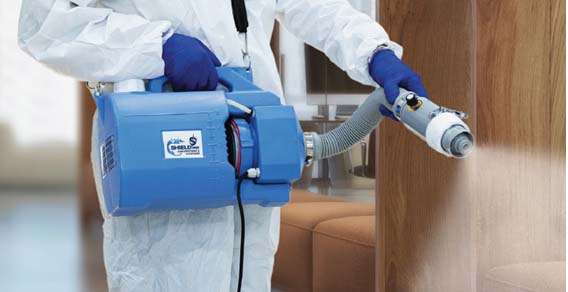Why Fogging ?
Fogging is a disinfectant process for which there is no substitute when ultra-penetrative disinfection is required. It is only fully effective when undertaken following a traditional spray/wipe cleaning of the target area since the micro-droplets generated in the fogging process can not make contact with a surface if the surface is obscured by debris. Fogging is the only effective method by which a virucide can be comprehensively distributed to all surfaces in a room.

What is fogging ?
Fogging consists of spraying a superfine mist throughout the entire room which covers every surface that is exposed to the air. The micro-fine droplets even kill airborne viruses which may not be present on any surface. The droplets are so fine that they float in the air long enough to disinfect ceilings and higher surfaces which would otherwise be out of reach. The droplets penetrate deep into gaps and crevices in every exposed surface, where viruses and bacteria can lie untouched by spray and wipe methods.
There are two categories of fogging: cold and thermal. Thermal foggers use heat to vaporise the chemical cleaner and cold foggers use air pressure. Thermal foggers are bigger and mostly used outdoors for pest control applications. They generate thick opaque fog which is not suited to indoor use.
Cold foggers are mostly of the ULV type, or Ultra-Low-Volume. They produce micro-droplets in the range 2-50 microns. For effective disinfection of many viruses, including coronavirus, the droplets should be less than 20 microns in size which means they are called dry fog. Fogs with droplets between 20-30 microns tend to be like vapour and are called wet fog. Above 30 microns in size the emission is more like a mist or a fine spray which may leave a residue on the surfaces as they dry. Dry fogging machines are most effective in viral disinfection because the smaller sized droplets can penetrate into minute cracks and crevices and fully cover those otherwise inaccessible surfaces.
The correct fogging machine must therefore be matched with the correct virucidal agent or the process will be ineffective. For killing Covid-19 this means using a chemical virucide that meets BS EN 14476 and which is formulated for use in a dry fogger, together with the appropriate ULV dry fogging machine.
Isn't normal cleaning sufficient ?
Cleaning is the removal of debris (both organic and inorganic) from hard and soft surfaces. In cleaning parlance this debris is called “soil” and the surface to which it has become attached is described as being “soiled”. Cleaning seeks to completely remove the “soil” from soiled surfaces but is not always successful, even using the most powerful cleaning agents. It is still possible to completely sanitise or disinfect a surface which has not been fully cleaned of soil (ie where discoloration or stains/marks remain). While many basic cleaning agents, including household bleach, are effective in killing Covid-19, it is not possible for them to reach everywhere that the virus could be present in a room.
What about manual sanitising or disinfecting ?
Sanitising is a deeper level of clean that targets invisible organisms (germs and bacteria) that may not have been killed by soil cleaning agents. Sanitising seeks to remove as much as possible of the germs and bacteria that exist on a surface but does not claim to kill all the organisms that may be present. General sanitising cleaning agents fall short of the capability to kill Covid-19.
Disinfecting is a more powerful cleaning process and aims to kill all microscopic organisms on a surface. The highest level of disinfecting is to produce a completely sterile environment. This is difficult to achieve because some organisms, notably certain viral strains, are resistant to the more common disinfectants. The first step to achieving a successful disinfectant clean is to use the appropriate disinfectant agent. This is particularly important in the case of Covid-19, or Coronavirus Sars Cov-2, for which very few disinfectants have been tested and proven to meet BS EN 14476.
To be confident of successfully killing Covid-19, the disinfectant used must meet BS EN 14476.
Fogging vs Spray/Wipe
The processes of Cleaning, Sanitising and Disinfecting are normally carried out using variations on the spray/wipe method, ie the cleaning agent is applied to a cloth or directly to the surface and manual or mechanical action is used to wipe it off.
Manual spray/wipe methods are time-consuming, labour intensive and not 100% effective. While many standard cleaning agents can kill pathogens such as coronavirus, they must be applied completely to every surface area in order to be effective. It is simply not possible to manually clean gaps and surfaces in awkward, hard to reach places. Fogging overcomes these problems.
